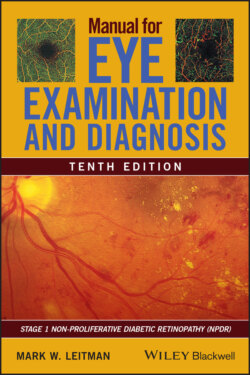Читать книгу Manual for Eye Examination and Diagnosis - Mark W. Leitman - Страница 10
Оглавление
Introduction to the eye team and their instruments
The eye exam depends on many sophisticated and costly instruments, together with highly trained professionals to operate them.
Ophthalmologist—The ophthalmologist attends 4 years of college, 4 years of medical (MD) or osteopathic (DO) school, and 3 years of specialty eye residency training. They may remain general ophthalmologists, but now, more often than not, spend an additional 1–2 years subspecializing in corneal and external disease, vitreoretinal disease, cataracts, glaucoma, neuro‐ophthalmology, oculoplastic surgery, pathology, pediatric (strabismus), or uveitis.
Optometrist (OD)—The optometrist completes 4 years of college and 4 years of optometry school. They perform similar tasks to the ophthalmologist, with subspecialty fellowships similar to ophthalmology, but with stress on medical, rather than surgical skills.
Opticians (ABO, American Board of Opticians)—Opticians grind the lenses and put them in frames (laboratory optician) or fit them on the patient (dispensing optician). Their training and certification is highly variable from state to state, but often includes 2 years at a community college.
Ocularists (BCO, BRDO, FASO)—Ocularists are few in number and often learn their craft by apprenticeship. They have to pass tests for certification. Their job is to fit the rarely needed sclera shell after removal of an eye (Figs 423–426).
Ophthalmic technicians—Ophthalmic technicians have varying degrees of licensure. With medical supervision, they may take medical histories; measure eye pressure; do refractions and visual field testing; take visual activities; teach contact lens fitting; and often assist in the following diagnostic tests.
Instruments
Routine diagnostic testing is done with a slit lamp (Fig. 237) for the anterior segment and the handheld ophthalmoscope (Fig. 466) for the retina exam. Office‐based optical coherence tomography (OCT) (Fig. 339) uses a light scanning device to measure the layers of the eye, and optical coherence tomography angiography (OCT A) physically defines the retinal and choroidal blood vessels. These light sources reflect a beam off ocular structures at up to 100,000 scans/s and require a clear, transparent media. A red blood cell has a diameter of 7 microns and OCT scans resolve down to 2–5 microns. Fluorescein angiography shows sequential blood flow and possible leakage of retinal blood vessels (Fig. 470). Ultrasound is an alternative to OCT for measuring structures through an opaque media (Fig. 560). A specular microscope (Figs 265 and 266) analyses the number and characteristics of the inner layer of the cornea called the endothelium. Corneal tomography (Fig. 73) measures the thickness and diopter power of the cornea. Treatments include lasers of different wave lengths. Argon lasers (see back cover) are preferred in the treatment of retinal disorders, and Nd:YAG lasers are used to open secondary cataracts (Figs 451 and 452) that occur after cataract extractions and to perform peripheral iridotomy for narrow‐angle glaucoma (Fig. 365). SLT Nd:YAG lasers (Fig. 345) are used to treat open‐angle glaucoma. Excimer lasers (Figs 60–62) change the shape of the cornea in the procedure called LASIK surgery. Femtosecond lasers help in certain parts of cataract surgery (Fig. 447) and SMILE refractive surgery (Fig. 77). Finally, the phacoemulsifier (Fig. 438) liquifies a 10‐mm cataract so that it can be removed through a sutureless, 3‐mm incision.
Fig 1 A seed introduced into the eye of an 8‐year‐old boy through a penetrating corneal wound became imbedded in the iris. Many months later, the seed became visible when it began germinating.
Courtesy of Solomon Abel, MD, FRCS, DOMS, and Arch. Ophthalmol., Sept. 1979, Vol. 97, p. 1651. Copyright 1979, American Medical Association. All rights reserved.
Dedicated to Andrea Kase
It is impossible to perform a good eye exam without a good support team. Andrea has enthusiastically led our team for 40 years as office manager, ophthalmic technician, and typist of all correspondence, including for the last eight editions of this book. By encouraging me to bring my collection of rocks and other exotic objects into the waiting room, she helped create a museum that my patients look forward to seeing.
